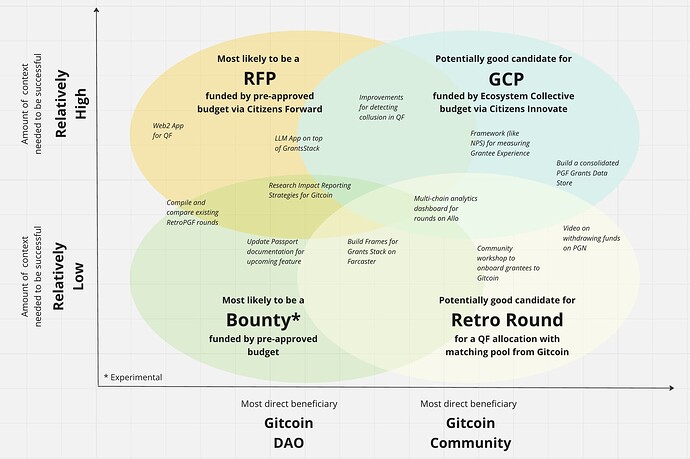The post covers the implementation details for the Gitcoin Citizen Grants Program proposal and offers a heuristic for roughly mapping funding options with types of community-led projects.
Here is a quick recap:
- Citizen Grants program comprises of Citizens Retro (Retroactive Funding), Citizens Innovate (Citizen Proposals) and Citizens Forward (RFPs) to foster innovation and community participation
- The one-stop shop for all information, support, and guidance for each of the three pillars is at gitcoin.co/citizens
- The Citizens Forward program is currently seeking innovative uses of Large Language Models (LLMs) in conjunction with Allo/Grants Stack. Check the RFPs posted here and here
- The very first GCP seeking the Citizens Innovate funds to boost the Gitcoin Grants Data Portal has been submitted here
- Dedicated office hours are available for those who are drafting proposals or seek to engage more deeply with the program. You can book them here.
The Problem space for Citizen Grants
Gitcoin firmly believes that grants programs are instrumental in ecosystem growth, and this program embodies that conviction. It provides various funding modalities tailored to diverse community-led initiatives. To understand the intersection of these funding options with different problem types, we must consider two key factors essential for clustering the problem space for citizen grants.
-
Minimum viable context - This refers to the essential context a team needs to address a problem successfully. There are a lot of open challenges in the Gitcoin ecosystem that are available for the community to attempt permissionlessly. On the other hand, certain problems require vital context about the product, data, community, or markets to drive relevant outcomes.
-
Most direct beneficiary - This identifies the primary beneficiary of the efforts, distinguishing whether it’s the DAO or the community that benefits more directly. While it’s important to acknowledge that many community-led initiatives provide value to both groups, the purpose of this distinction is strategic: it aims to prioritize and determine the most suitable funding options.
By examining these factors, we can better navigate and strategize the allocation of resources based on the attributes of the problem. Here is a probabilistic distribution of the problems against the two criteria.
Although not mutually exclusive, the four categories of problems delineate unique challenges that the DAO aims to address with community contributions. As a result, each category necessitates a distinct approach to funding. This differentiation acknowledges that the nature of the problems varies, and so should the strategies for engaging the community and allocating resources.
A probabilistic map of opportunities and funding options
The following landscape, which aligns funding options with representative examples, is loosely deterministic and serves as a framework for understanding the interplay between different funding categories. It’s crucial to note the overlapping areas among the four categories, emphasizing that this landscape should be seen as a guideline rather than a strict rule.
How to read this?
-
Community-led initiatives aimed at supporting the DAO’s established priorities should adopt a structured approach, utilizing Requests for Proposals (RFPs) or bounties. This method ensures that contributors are compensated immediately upon delivering proof of their work rather than waiting for the next Retro funding round.
-
The single source of truth for eligibility for the Retro Round will be the criteria released ahead of each iteration; however, we expect a vast majority of the grantees in the retro round to be individuals who complement the existing DAO priorities by adding value to the stakeholders in the Gitcoin ecosystem.
-
More complex, multi-disciplinary projects from the community that aim to expand Gitcoin’s impact should be considered for evaluation in the monthly funding cycle within the Citizens Innovate program. This approach ensures that larger-scale efforts, which likely require more substantial resources and coordination, receive the appropriate attention and funding.
Conclusion
While this landscape offers direction, it allows for interpretive leeway, accommodating the dynamic nature of funding decisions and the nuanced needs of each category. We anticipate a reinforcing cycle where successful initiatives from the Retro Round, like the Gitcoin Grants Data Portal proposal, can transition into the Citizens Innovate program, thereby scaling their impact. By tailoring funding approaches to the specific characteristics of each problem category, we can more effectively harness community contributions and drive targeted outcomes.
Whether you’re an innovator, a builder, or someone passionate about driving change, we hope the program offers a platform to contribute, engage, and make a difference. Your feedback is highly appreciated as we identify more opportunities for community contributions across the DAO.

